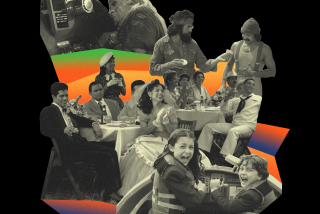Review: Mexico’s ‘I’m No Longer Here’ spans the gap between alienation and connection
The need to move becomes more than just a dance impulse to the young leader of a close-knit but threatened Monterrey, Mexico counterculture in Fernando Frias de la Parra’s sensitive, beautifully filmed and music-laden “I’m No Longer Here,” a cinematic duet of rhythm and rootlessness that is also Mexico’s entry for this year’s international feature Oscar.
Toggling between the communally strong but violence-ridden hills of Northern Mexico and the confounding maze of cultures that is New York to a reluctant transplant, Frias’ movie lands nowhere easily for its 17-year-old protagonist Ulises (Juan Daniel Garcia), whose life of dance parties and camaraderie is upended by having to leave home. (This movie starkly reminds us that not all immigration stories are driven by promises or a desire to go.) But in its exploration of the forces that pull us — whether toward or away from what we love — and the ills that throw us off the beat, this movie oozes compassion for the rebel hearts of immigrants everywhere.
Frias has a powerful, specific cultural lens too, through which to tell this tale: the youth-driven Cholombiano sub-culture of Monterrey that flourished at the turn of the 2010s, a home-brewed blend of purposefully slowed-down cumbias (the already low-gear, mixed-cultures Colombian export beloved across Latin America), expressive sartorial cues from the boldly patterned and baggy cholo aesthetic, and severely shaped hairstyles emphasizing the shaved, the gelled, the tufted, the highlighted and the sharply banged.
When we first meet the stoic, slightly built Ulises — at the turning point of his life, saying goodbye to his friend Chaparra (Coral Puente) on a lonely stretch of road before getting into a stranger’s car to make his journey to the United States — the colorful rigor of his fashion-conscious look seems out of step with a moment hardly worth celebrating. Once in Jackson Heights, Queens, and navigating glares, bullying, solitude and a language he doesn’t understand, he seems like a captive rare bird on the verge of molting.
Once Frias begins threading in flashbacks to only a few months prior, when Ulises is running with his compact, proud, outsider-friendly Los Terkos crew and a party is in full swing or a get-together in an abandoned building segues into lyrics, beats and glorious steps, we see him in his element. The cumbia rebajada is his joys-and-sorrows heartbeat, his sinuous, twirling dances a disarming mating call for like-minded souls.
As Frias continues to parallelize his narrative between America and Mexico, the two strands begin to feel less like jumps in time than a dialectic about alienation and connection, color and darkness. In a New York of cold concrete and shadows, his plight draws the sympathetic engagement of Lin (Angelina Chen), a Chinese bodega owner’s teenage granddaughter, but does the friendship equate to a sense of belonging? In Monterrey, Ulises knows how to welcome a picked-on kid into the vibrant Terkos way of life but can any of them survive the pervasive threat of bloodshed and poverty with their street bond intact?
The international film Oscar entry crafts a tale set among gangs in poverty-stricken and hyper-violent settlements near Monterrey
Frias (who also directed the charmingly eccentric HBO Max comedy series “Los Espookys”) and his gifted cinematographer Damían García keep this visual duality thrillingly alive with compositions that often use corners or reflective surfaces to split images, and that highlight vectors — a wall, a road, a fire escape ladder — to keep us thinking of directions and pathways.
When the image concentrates on its lead Garcia, a non-professional among many in “I’m No Longer Here,” the camera respects his tight-lipped authenticity rather than exploits it. What emerges is a character whose carefully curated, youthful exterior easily commands the frame, but whose old-soul identity gets to contextualize it in doses, aided by the music from his MP3 player that not only speaks to him, but in cumbia’s words of warmth and loss, often for him. It’s a deceptively dimensional portrayal, that of someone who worries his stage is getting smaller and smaller. And in Frias’ magnetic feature is enough spirit, sound and artistry to give his journey a meaningful spotlight.
'I’m No Longer Here'
In Spanish and English with English subtitles
Not rated
Running time: 1 hour, 52 minutes
Playing: Available on Netflix
More to Read
Only good movies
Get the Indie Focus newsletter, Mark Olsen's weekly guide to the world of cinema.
You may occasionally receive promotional content from the Los Angeles Times.










